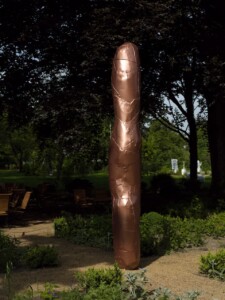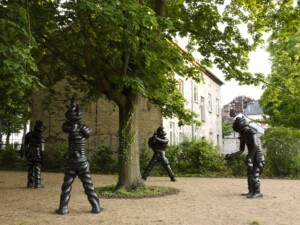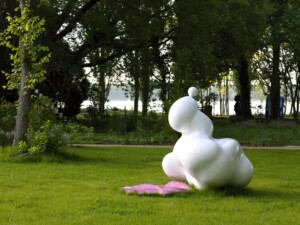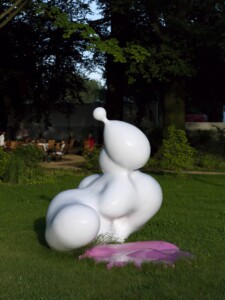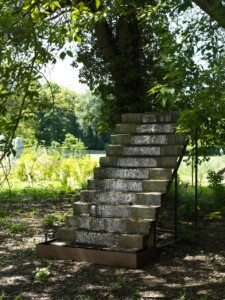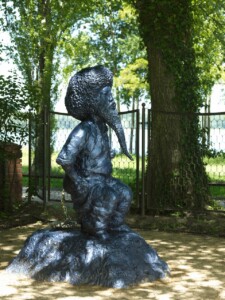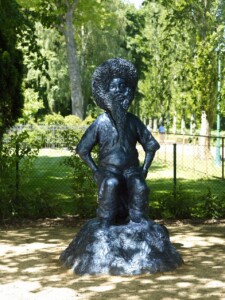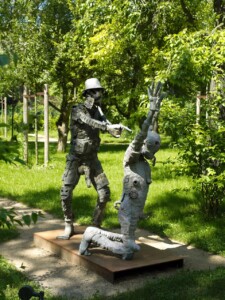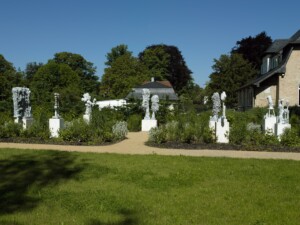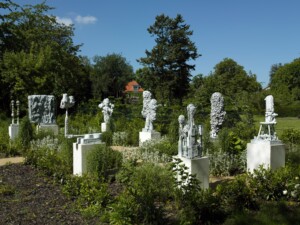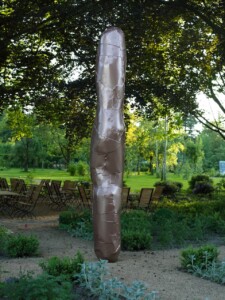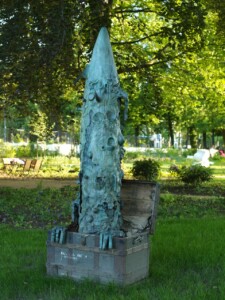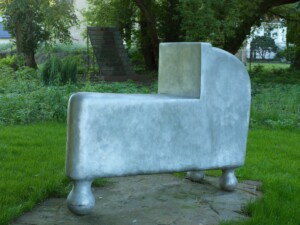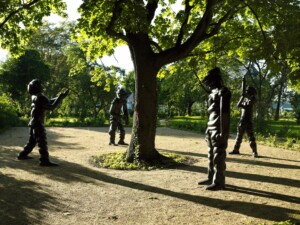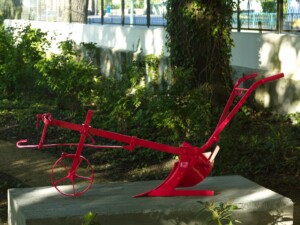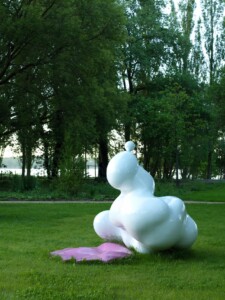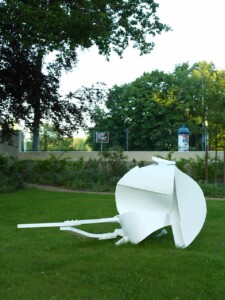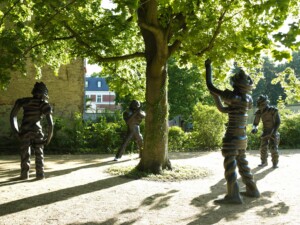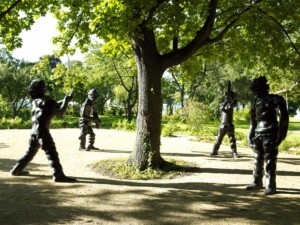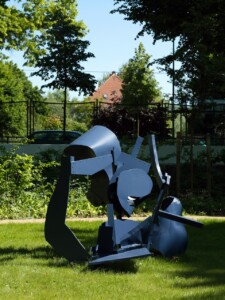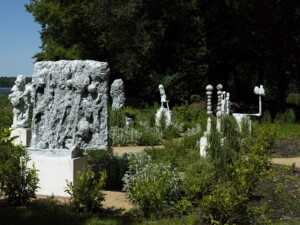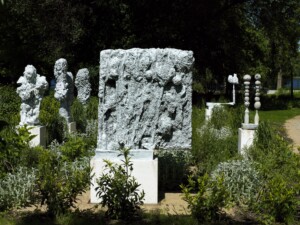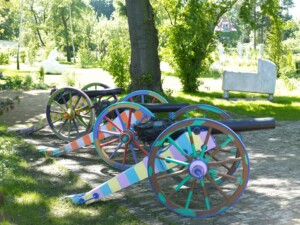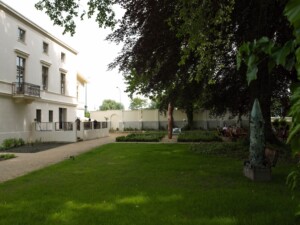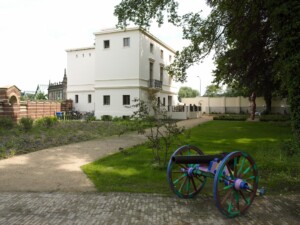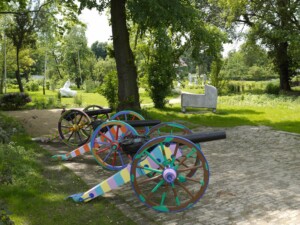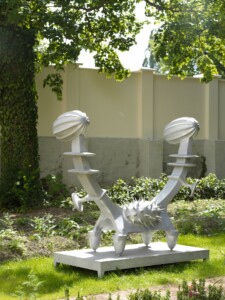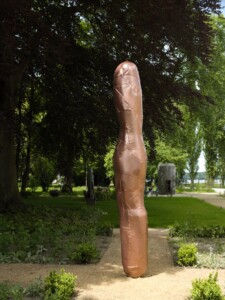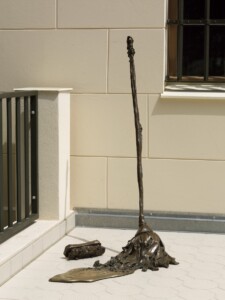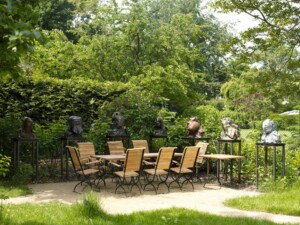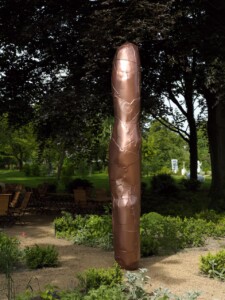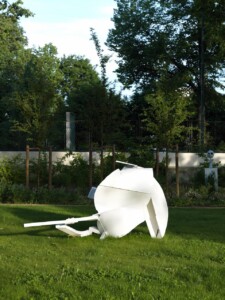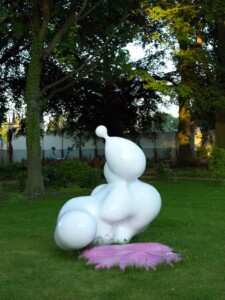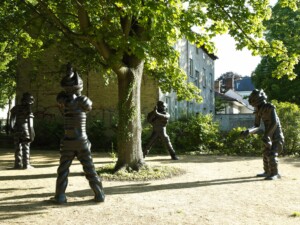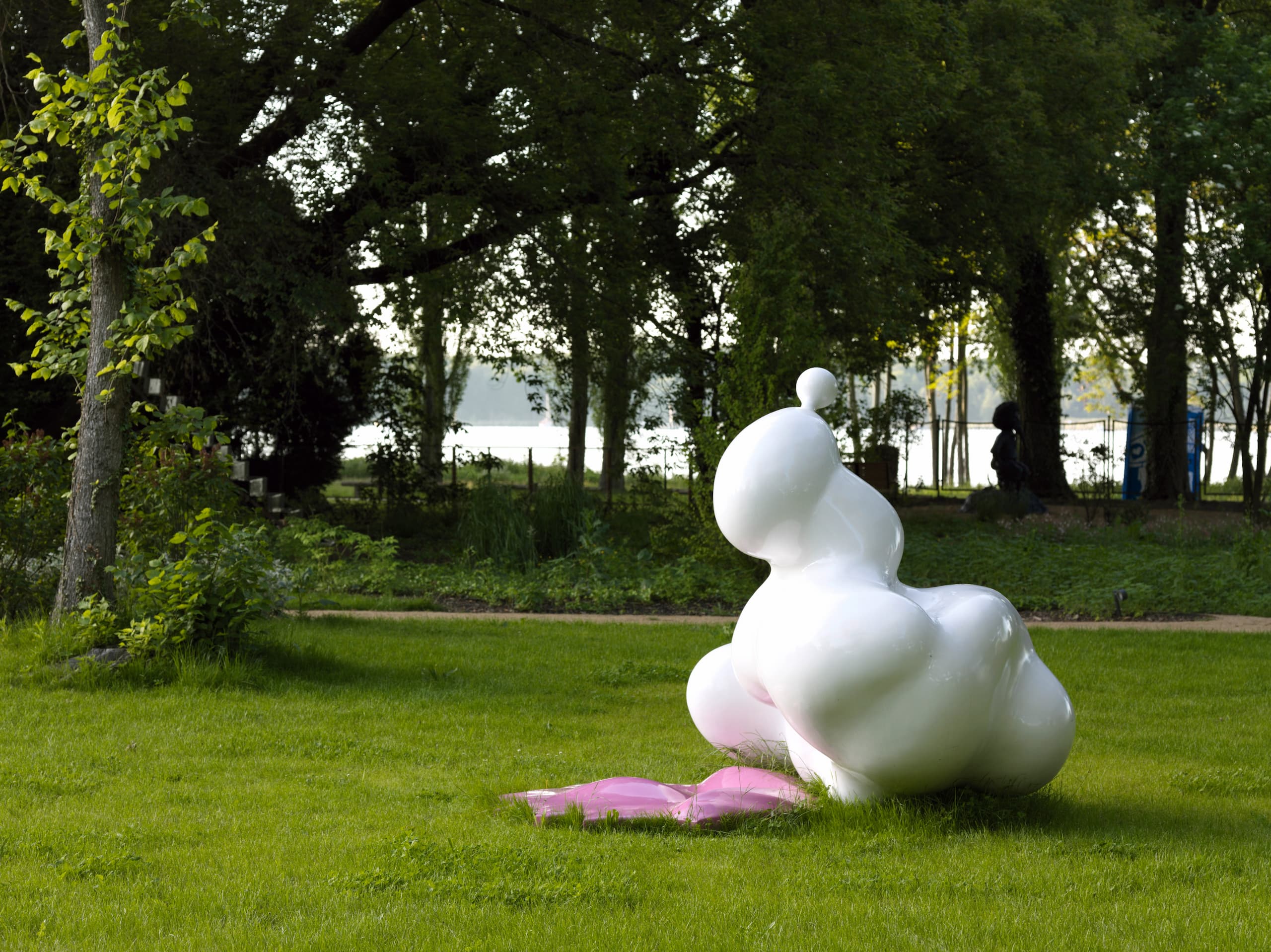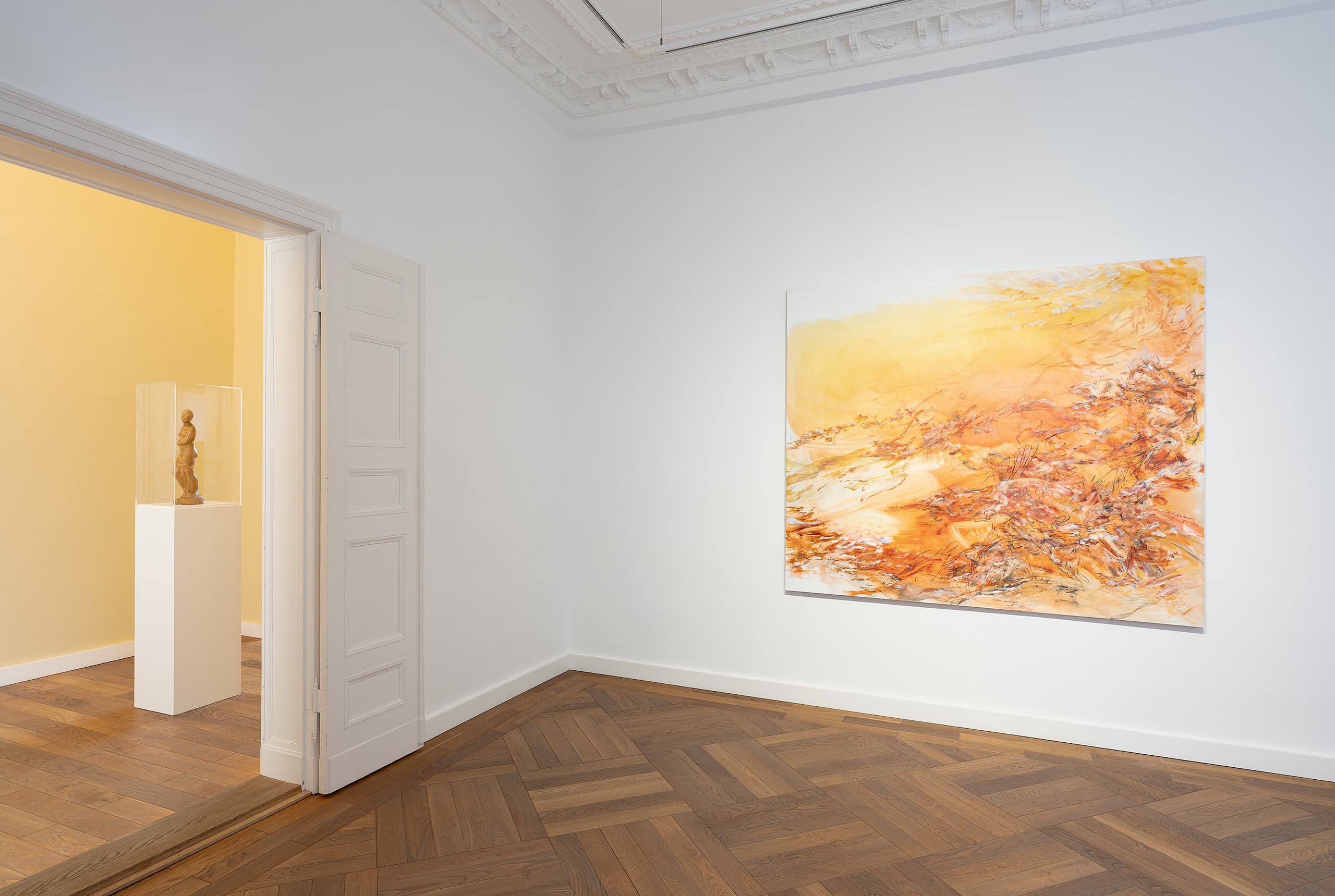Sculpture garden
Berlin, with its outstanding art and gallery scene, has shown in recent years with what strength and fascinating diversity contemporary art can claim space, generate attention, and have an impact in this metropolis. The unique and identity-shaping position that numerous artists in the German capital now hold – and perhaps even feel compelled to hold – is influential throughout the urban fabric.
Potsdam, the neighboring city of palaces and gardens, is an official UNESCO World Heritage Site, where contemporary art plays a minor, perhaps even no role at all. For some, this may even be considered a blessing. Now, in and around the Villa Schöningen in Potsdam, a central place that not only encapsulates a tumultuous chapter of German history but also speaks to the changing times and the possibilities that arise from them, contemporary art is set to become an element of identity as well. Some may wonder whether contemporary art in Potsdam, amidst its historic surroundings, is even necessary. However, the necessity to vigorously affirm this and act accordingly arises from the unique identities of the place and its development. The Villa Schöningen, that is the clear objective, should not only be a house of remembrance but also a joyful place of freedom, not just a space of history but also of the present.
For artists, this certainly presents a highly interesting opportunity for exhibition. How often does the chance arise to find a place for contemporary art amid a UNESCO World Heritage Site, within the framework of a conceptual overall aesthetic, amidst a romantic landscape of palaces and gardens? The garden of Villa Schöningen is therefore a spatial reality with numerous historical connotations, but also with potential for impact and freedom of expression – an extraordinary platform for contemporary art.
The special advantage of the situation lies elsewhere entirely. It is the freedom, even nonchalance, that the specific structure offers. The owners of the “house,” who are known in their professional environment for a certain penchant for leadership and control, want to give free rein to art in Villa Schöningen and are evidently enthusiastic about almost any experiment. With the rather rudimentary intention that contemporary art should also have its place in the garden of the historic villa, that it must fundamentally shape the place, they left further action to the energy of galleries and artists. In such a spontaneous and freely developing activity, a first ensemble of sculptures was assembled in a very short time. In just a few weeks, within the framework of a “group dynamic” process primarily shaped by the enthusiastic commitment and attention of the artists, a collection of special works came together, which will now take possession of the garden of Villa Schöningen for some time.
The two operators of Villa Schöningen have saved this place through philanthropic action, rebuilt it, and now they are turning it into an experiment, perhaps – in terms of their open approach – even one with themselves. They certainly have enough public attention, as they operate in very prominent positions in the media and finance world in their daily lives. Thus, within the scope of their social commitment to this museum, it is not about personal recognition or social status. Instead, the intention of Villa Schöningen is to evoke movement, development, joy, and inspiration at this crucial point in German history. The garden of this historic place should also belong to the public, not a hortus conclusus but an expanding field of possibilities that needs further development. The owners of Villa Schöningen are two extraordinarily dedicated citizens, and the owner of Villa Schöningen is the public – and now, also art.
Max Hollein
 © Villa Schöningen, Foto: Jochen Lipkemann
© Villa Schöningen, Foto: Jochen Lipkemann
 © Villa Schöningen, Foto: Jochen Lipkemann
© Villa Schöningen, Foto: Jochen Lipkemann
 © Villa Schöningen, Foto: Jochen Lipkemann
© Villa Schöningen, Foto: Jochen Lipkemann
 © Villa Schöningen, Foto: Jochen Lipkemann
© Villa Schöningen, Foto: Jochen Lipkemann
 © Villa Schöningen, Foto: Jochen Lipkemann
© Villa Schöningen, Foto: Jochen Lipkemann
 © Villa Schöningen, Foto: Jochen Lipkemann
© Villa Schöningen, Foto: Jochen Lipkemann
 © Villa Schöningen, Foto: Jochen Lipkemann
© Villa Schöningen, Foto: Jochen Lipkemann
 © Villa Schöningen, Foto: Jochen Lipkemann
© Villa Schöningen, Foto: Jochen Lipkemann
 © Villa Schöningen, Foto: Jochen Lipkemann
© Villa Schöningen, Foto: Jochen Lipkemann
 © Villa Schöningen, Foto: Jochen Lipkemann
© Villa Schöningen, Foto: Jochen Lipkemann
 © Villa Schöningen, Foto: Jochen Lipkemann
© Villa Schöningen, Foto: Jochen Lipkemann
 © Villa Schöningen, Foto: Jochen Lipkemann
© Villa Schöningen, Foto: Jochen Lipkemann
 © Villa Schöningen, Foto: Jochen Lipkemann
© Villa Schöningen, Foto: Jochen Lipkemann
 © Villa Schöningen, Foto: Jochen Lipkemann
© Villa Schöningen, Foto: Jochen Lipkemann
 © Villa Schöningen, Foto: Jochen Lipkemann
© Villa Schöningen, Foto: Jochen Lipkemann
 © Villa Schöningen, Foto: Jochen Lipkemann
© Villa Schöningen, Foto: Jochen Lipkemann
 © Villa Schöningen, Foto: Jochen Lipkemann
© Villa Schöningen, Foto: Jochen Lipkemann
 © Villa Schöningen, Foto: Jochen Lipkemann
© Villa Schöningen, Foto: Jochen Lipkemann
 © Villa Schöningen, Foto: Jochen Lipkemann
© Villa Schöningen, Foto: Jochen Lipkemann
 © Villa Schöningen, Foto: Jochen Lipkemann
© Villa Schöningen, Foto: Jochen Lipkemann
 © Villa Schöningen, Foto: Jochen Lipkemann
© Villa Schöningen, Foto: Jochen Lipkemann
 © Villa Schöningen, Foto: Jochen Lipkemann
© Villa Schöningen, Foto: Jochen Lipkemann
 © Villa Schöningen, Foto: Jochen Lipkemann
© Villa Schöningen, Foto: Jochen Lipkemann
 © Villa Schöningen, Foto: Jochen Lipkemann
© Villa Schöningen, Foto: Jochen Lipkemann
 © Villa Schöningen, Foto: Jochen Lipkemann
© Villa Schöningen, Foto: Jochen Lipkemann
 © Villa Schöningen, Foto: Jochen Lipkemann
© Villa Schöningen, Foto: Jochen Lipkemann
 © Villa Schöningen, Foto: Jochen Lipkemann
© Villa Schöningen, Foto: Jochen Lipkemann
 © Villa Schöningen, Foto: Jochen Lipkemann
© Villa Schöningen, Foto: Jochen Lipkemann
 © Villa Schöningen, Foto: Jochen Lipkemann
© Villa Schöningen, Foto: Jochen Lipkemann
 © Villa Schöningen, Foto: Jochen Lipkemann
© Villa Schöningen, Foto: Jochen Lipkemann
 © Villa Schöningen, Foto: Jochen Lipkemann
© Villa Schöningen, Foto: Jochen Lipkemann
 © Villa Schöningen, Foto: Jochen Lipkemann
© Villa Schöningen, Foto: Jochen Lipkemann
 © Villa Schöningen, Foto: Jochen Lipkemann
© Villa Schöningen, Foto: Jochen Lipkemann
 © Villa Schöningen, Foto: Jochen Lipkemann
© Villa Schöningen, Foto: Jochen Lipkemann
